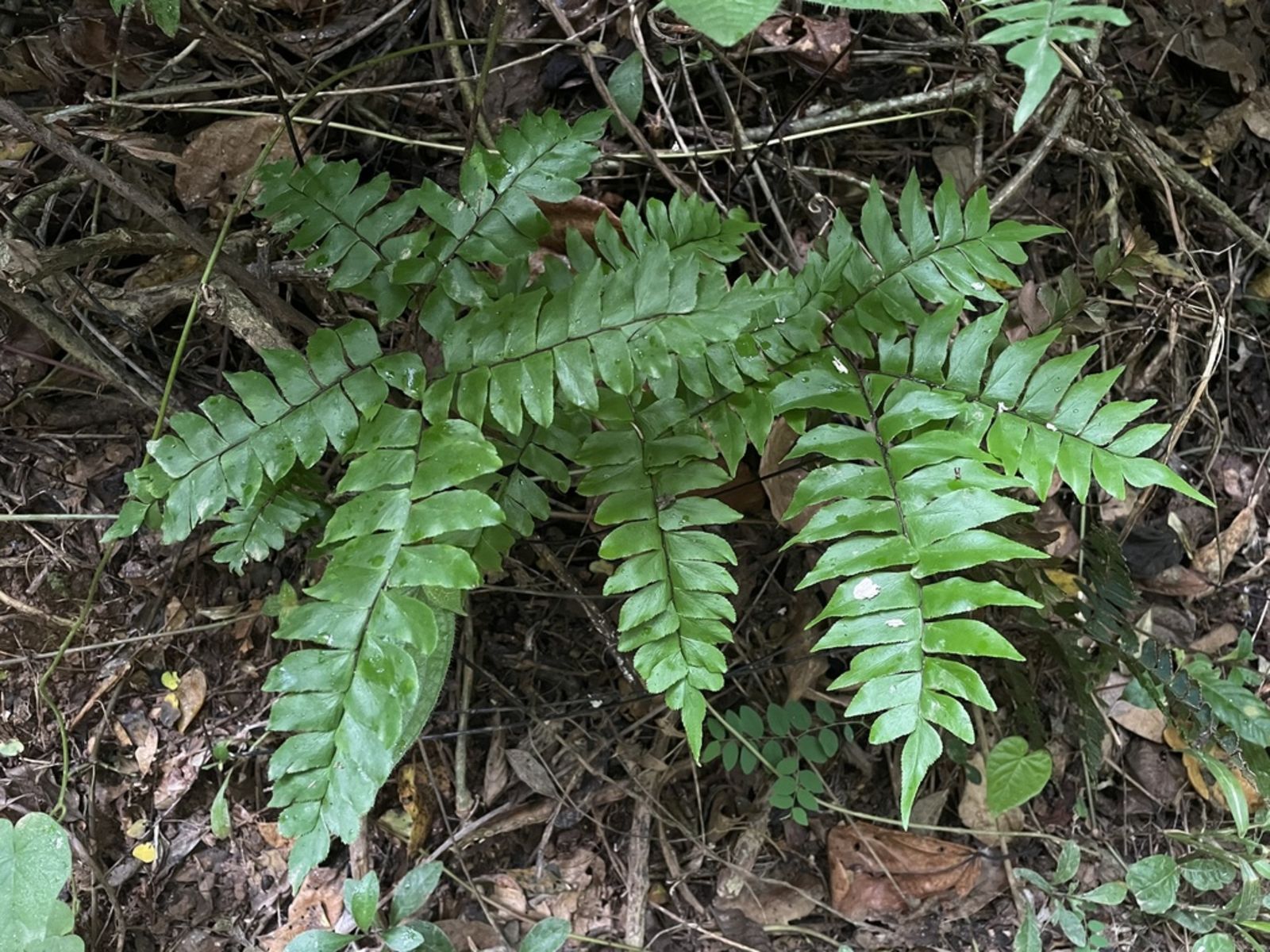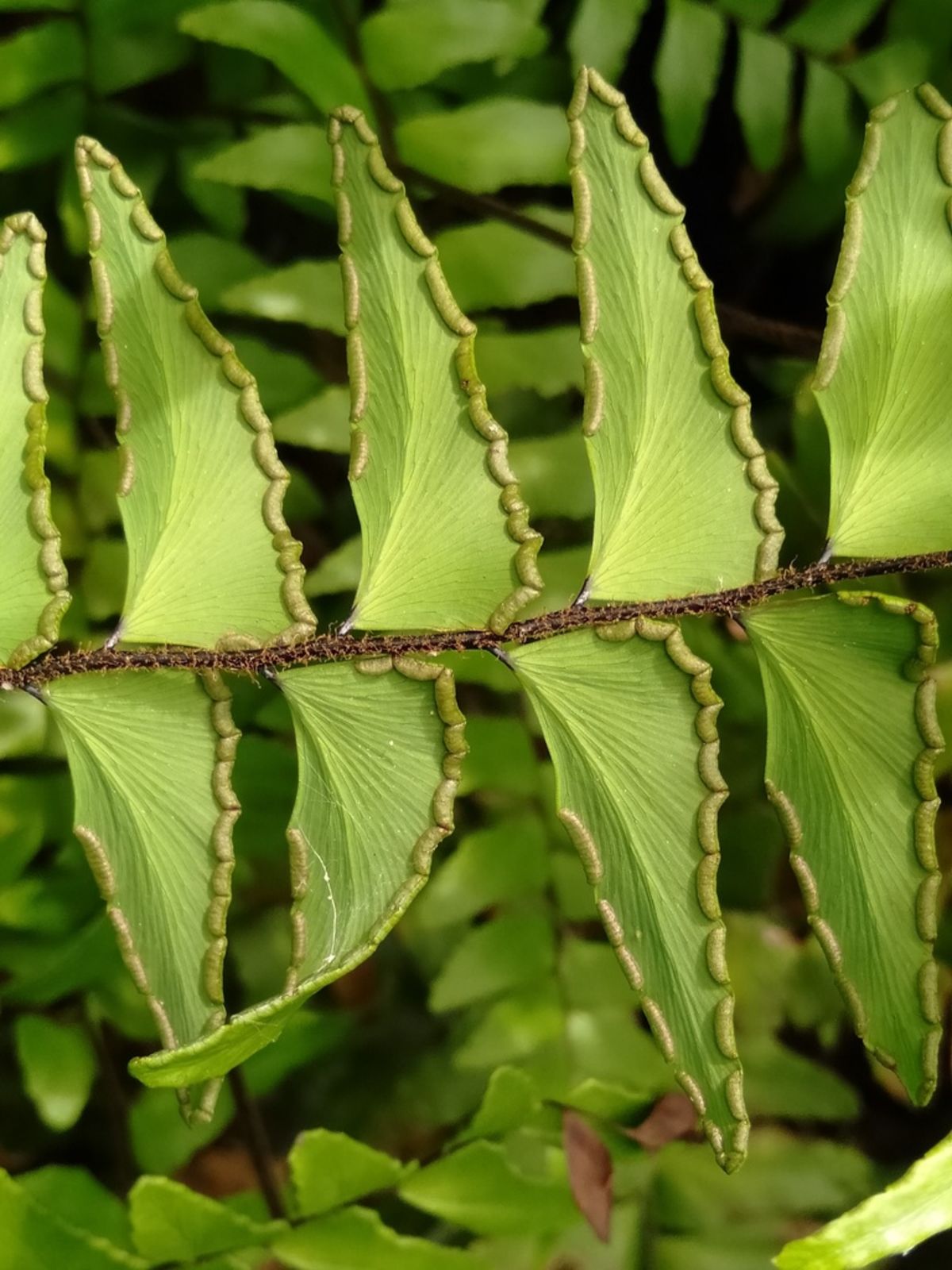Broadleaf Maidenhair Fern
adiantum latifolium
Also known as: ["Broadleaf Maidenhair","Elegant Maidenhair"]
Overview
A delicate, deciduous fern with fan-shaped leaflets on black stems, native to tropical and subtropical regions.
Benefits & Perks
["shade tolerant","aesthetic foliage","wildlife attractant (bees, butterflies, birds)"]
Botanical Classification
| Phylum: | Tracheophyta |
| Class: | Polypodiopsida |
| Order: | Pteridales |
| Family: | Pteridaceae |
| Genus: | Adiantum |
| Botanical Name: | Adiantum latifolium |
Plant Characteristics
Basic Information
- Category: Leaf Plants
- Suitable Location: shaded garden bed or indoor pot in a humid environment
- Suitable For:
- Is Weed: No
- Allergenicity: low
Environmental Needs
- Climate: {"temperatureRange":"10–30°C"}
- Hardiness: {"zones":"8–11"}
- Misting: every 2–3 days to maintain high humidity
- Drainage: Fast-draining to prevent waterlogging.
- Soil Type: Well-draining, rich, slightly acidic soil; mix of peat, sand, and loam works well.
Maintenance Level
- Maintenance Level: moderate
- Toughness Level: moderate
- Pruning Frequency: As needed, typically every few months or when fronds look unsightly.
- Pruning Intensity: Light to moderate; focus on removing only dead or damaged growth.
Care Details
Ideal Sunlight Coverage:
Bright indirect light for 6–8 hours/day; adjust to lower light in winter to prevent scorching.
Sunlight Tolerance Tips:
Acclimate gradually to brighter light; protect from direct sunlight to avoid scorching; place in a shaded spot outdoors if moved from indoors.
Care Requirements
Care Difficulty
moderatemoderate
Sunlight
partial shade to filtered light
Avoid direct sun; rotate plant for even growth; adjust light levels seasonally.
Watering
every 5–7 days, allowing soil to dry slightly between waterings
Keep soil consistently moist but not waterlogged; avoid letting the soil dry out completely; ensure good drainage to prevent root rot.
Soil
moist, well-draining, peat-based potting mix
pH: Slightly acidic to neutral (pH 5.5–6.5).
Ensure good drainage, maintain slightly acidic pH, avoid heavy clay soils.
Temperature
Prefers 60–75°F (15–24°C); tolerates mild fluctuations but dislikes extreme heat or cold.
Avoid sudden temperature changes; protect from drafts; maintain moderate temperatures.
Fertilizing
every 4–6 weeks during growing season with diluted liquid fertilizer
Dilute fertilizer to prevent burn; fertilize during active growth; stop in winter.
Propagation
Methods
Division or spores; division is more reliable for home growers.
Step-by-Step Propagation Guide
- Divide clumps into smaller sections with roots.
- Plant each section in its own pot.
- Water lightly and maintain humidity.
Best Time: Spring or early summer when the plant is actively growing.
Environment
High humidity, indirect light, warm temperatures (65–75°F or 18–24°C).
Medium
Peaty, well-draining soil mix; can also use sphagnum moss.
Hormone
Not necessary for division; optional for spore propagation to encourage germination.
Timeline
Division: immediate establishment; spores: 1–3 months for germination, 6–12 months to mature.
Tools Needed
Sharp, sterile knife or shears, pots, well-draining soil mix.
Quick Tips
Ensure each division has roots; maintain humidity after division; use clean tools to prevent disease.
Pruning & Repotting
Pruning Guide
Method
Snip individual fronds at the base with clean, sharp scissors or pruners.
Pruning Plan
Remove dead or damaged fronds to maintain appearance and health; occasional shaping to control size.
Tools
Sharp, clean scissors or pruners.
Checklist
Identify dead/damaged fronds, use clean tools, cut close to the base, dispose of clippings.
Repotting Guide
Best Season
Spring, before the growing season begins.
Pot Size
One size up from current pot; ensure good drainage holes.
Method
Remove plant gently, trim any dead roots, place in a slightly larger pot with fresh, well-draining soil, water lightly.
Suggestions
Repot every 2–3 years or when the plant becomes root-bound; helps refresh soil and provides space for growth.
Checklist
Choose appropriate pot, prepare fresh soil, handle roots carefully, water after repotting.
Advanced Care Tips
Watering Mastery
Watering Checklist
Check soil moisture, water thoroughly, ensure drainage, avoid wetting foliage.
How to Apply Water Properly
Water thoroughly until water drains from the bottom; focus on the root zone; allow excess water to drain away; water in the morning to reduce evaporation.
Watering Schedule Tips
Water when the top inch of soil feels dry; increase frequency during hot, dry periods; reduce in winter to prevent root rot.
Soil Improvement
Add perlite or sand for drainage; incorporate organic matter like peat moss for moisture retention.
Temperature Stress Management
Signs of Temperature Issues
Yellowing or browning of fronds, stunted growth, or wilting.
Cold Stress
Slows growth, causes fronds to turn brown or black, may lead to root damage.
Solution: Move to a warmer location; protect from drafts; maintain consistent temperatures above 50°F (10°C).
Hot Stress
Fronds may wilt, turn yellow, or brown; growth may slow or stop.
Solution: Provide shade; increase humidity; water more frequently but avoid waterlogging.
Fertilizing Guide
Fertilizing Checklist
Use diluted fertilizer, fertilize monthly in growing season, avoid winter feeding.
Fertilizing Method
Use a balanced liquid fertilizer diluted to half strength; fertilize monthly during growing season (spring/summer); avoid fertilizing in fall/winter.
Common Problems & Solutions
Toxicity Warning
Cats
Non-toxicAdiantum latifolium is not toxic to cats. It poses no known health risks to felines when ingested or touched.
⚡ Toxic If:
None
Dogs
Non-toxicAdiantum latifolium is not toxic to dogs. There are no known harmful effects associated with ingestion or contact with this plant.
⚡ Toxic If:
None
Humans
Non-toxicAdiantum latifolium, commonly known as the American Maidenhair Fern, is not considered toxic to humans. It has no known adverse effects on human health when handled or ingested.
⚡ Toxic If:
None
Frequently Asked Questions
Q: How often should I water Adiantum latifolium?
A: Keep the soil consistently moist but not waterlogged; water when the top inch of soil feels dry.
Q: Does this fern need direct sunlight?
A: No, it prefers partial to full shade and bright, indirect light.
Q: Can I grow Adiantum latifolium indoors?
A: Yes, it thrives indoors in a humid environment with indirect light.
Quick Reference
| Family: | Pteridaceae |
| Care: | moderate |
| Light: | partial shade to filtered ligh |
| Water: | every 5–7 days, allowing soi |
Get Expert Care Tips
Download the Plantious app for personalized care reminders and plant identification!
Google Play App Store








